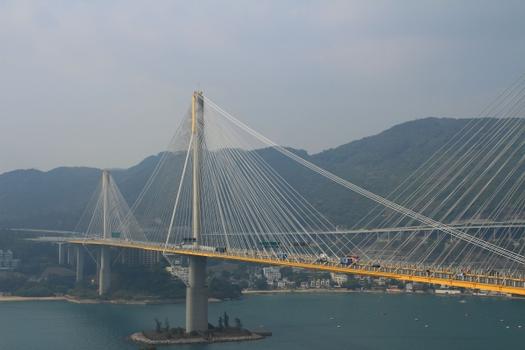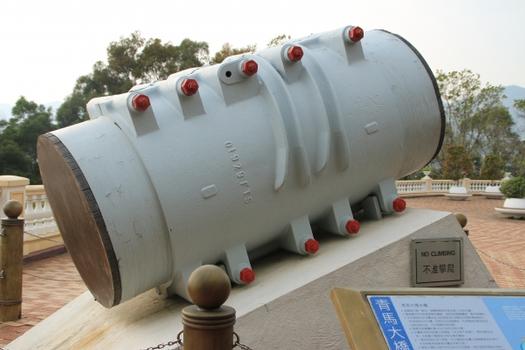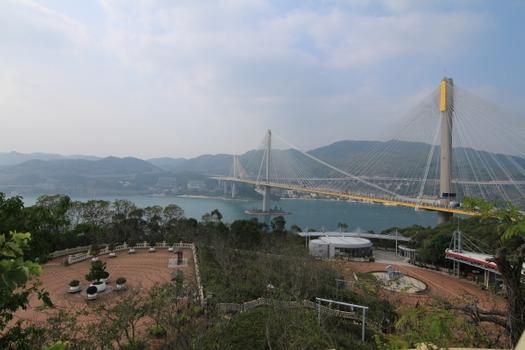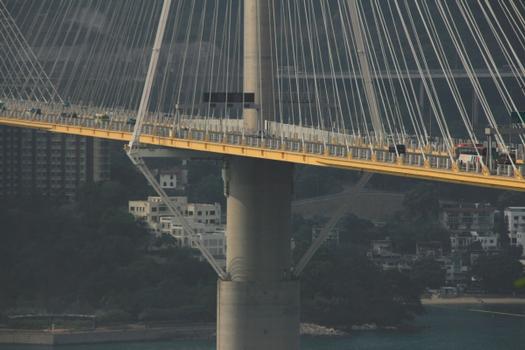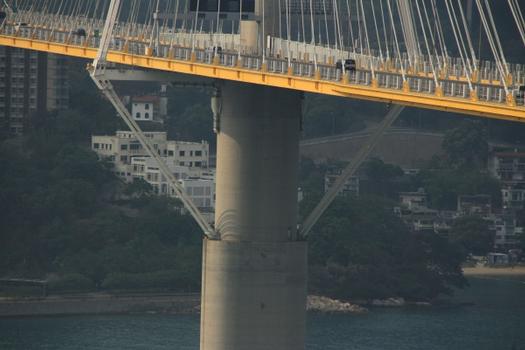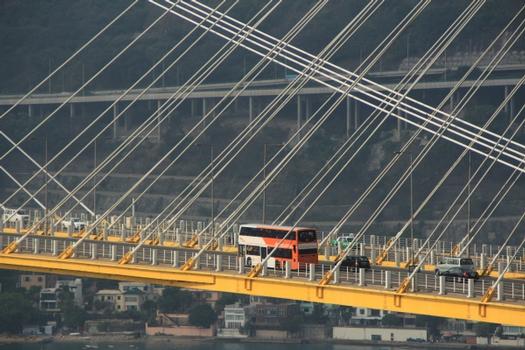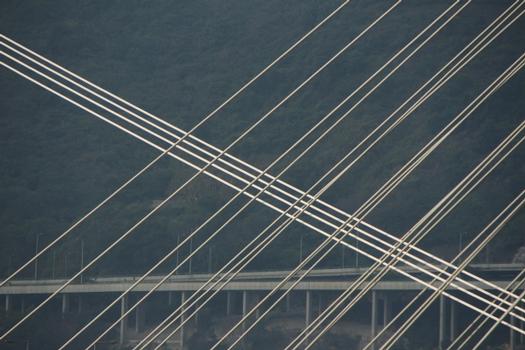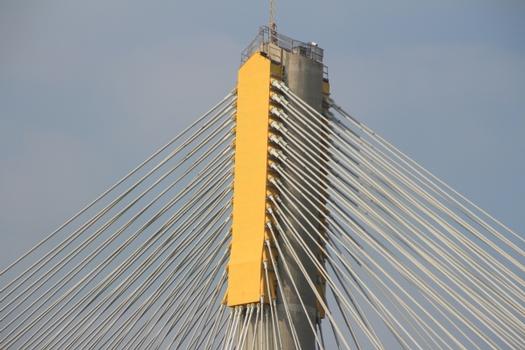General Information
| Name in local language: | 汀九桥 (汀九橋) = Tīngjiǔ Qiáo |
|---|---|
| Beginning of works: | 1995 |
| Completion: | 5 May 1998 |
| Status: | in use |
Project Type
| Structure: |
Multiple-span cable-stayed bridge |
|---|---|
| Function / usage: |
Motorway bridge / freeway bridge |
| Structure: |
Cable-stayed bridge with semi-fan system |
| Material: |
Steel-reinforced concrete composite bridge |
| Support conditions: |
for registered users |
| Material: |
Structurae Plus/Pro - Subscribe Now! |
| Secondary structure(s): |
Structurae Plus/Pro - Subscribe Now! |
| Material: |
Structurae Plus/Pro - Subscribe Now! |
| Secondary structure(s): |
Structurae Plus/Pro - Subscribe Now! |
Location
| Location: |
Tuen Mun, Hong Kong, China Tsing Yi, Kwai Tsing, Hong Kong, China |
|---|---|
| Coordinates: | 22° 21' 50.56" N 114° 4' 47.20" E |
Technical Information
Dimensions
| total length | 1 675 m | |
| bridge surface | 46 000 m² | |
| deck | width | 2 x 18.77 m |
| number of lanes | 2 x 3 | |
| piers | height | max. 65 m |
| deck depth at abutments | 21 | |
| main bridge | ||
|---|---|---|
| total length | 1 177 m | |
| span lengths | 127 m - 448 m - 475 m - 127 m | |
| number of spans | 4 | |
| cables | strands per cable | 20 - 60 (15 mm) |
| pylon Central | height | 194 m |
| pylon head Central | height | 31 m |
| weight | 190 m | |
| pylon head Ting Kau | height | 21 m |
| weight | 140 t | |
| pylon head Tsing Yi | height | 162 m |
| weight | 140 t | |
| pylon Ting Kau | height | 167 m |
| pylon Tsing Yi | height | 162 m |
| stay cables | number of cables | 384 |
Quantities
| volume of extracted material | 675 000 m³ | |
| volume of earthworks | 50 000 m³ | |
| deck | structural steel | 9 000 t |
| reinforcing steel content | 80 kg/m² | |
| main bridge | ||
|---|---|---|
| pylons | structural steel | 1 300 t |
| reinforcing steel content | 200 kg/m² | |
| stay cables | steel for cable-stays | 2 800 t |
Design Loads
| wind resistant to | 95 m/s |
Materials
| pylons |
reinforced concrete
|
|---|---|
| deck slab |
reinforced concrete
|
| cross beams |
steel
|
| girders |
steel
|
Case Studies and Applied Products
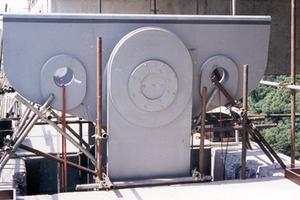
mageba Special Bearings
mageba has more than 40 years manufacturing know-how in the manufacturing of special bearings.
[more]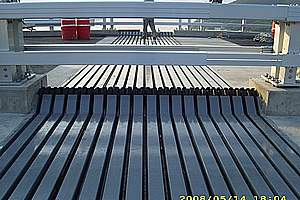
TENSA®MODULAR LR & LR-LS – Modular expansion joints
Modular Expansion Joints can be constructed for any movements, from about 100 mm up to 2,000 mm and more. They allow movements in all 3 directions and rotations around all 3 axes.
[more]Excerpt from Wikipedia
Ting Kau Bridge is a 1,177-metre (3,862 ft) long cable-stayed bridge in Hong Kong that spans from the northwest of Tsing Yi Island and Tuen Mun Road. It is near the Tsing Ma Bridge which also serves as a major connector between the Hong Kong International Airport on Lantau Island and the rest of Hong Kong. It was completed on May 5, 1998. The bridge is toll-free.
The bridge is part of Route 3, connecting Northwest New Territories with Hong Kong Island. Other major structures on the road include the Tai Lam Tunnel, the Cheung Tsing Tunnel, the Cheung Tsing Bridge and the Western Harbour Crossing. The Ting Kau Bridge carries the heaviest traffic volume of the bridges on the Lantau Link, with many container trucks travelling between mainland China and the HK container port. A chromatic study and specially designed architectural lighting are intended to set the bridge off in its surroundings.
Design
Ting Kau Contractors Joint Venture designed and built Ting Kau Bridge between 1995 and 1998. The joint venture consisted of lead partners Cubiertas Y Mzov (22%) and Entrecanales Y Tavora (22%), both of Spain (now both part of Acciona, S.A); Germany's Ed. Züblin (22%); Australia's Downer and Co (22%); and Hong Kong's Paul Y (12%). Constructing engineers were Schlaich Bergermann & Partner.
The design and construction cost of the bridge was HK$1.94 billion. It is one of the longest cable-stayed bridges in the world. Along with the Tsing Ma and Kap Shui Mun bridges, it is closely monitored by the Wind and Structural Health Monitoring System (WASHMS).
Ting Kau Bridge is the world's first major 4-span cable-stayed bridge. This meant that the central tower had to be stabilised longitudinally, which was accomplished using the longest cable stays ever used in a bridge (465 m (1,526 ft)). The design of this bridge contains special features such as single leg towers, which are stabilised by transverse cables like the masts of a sailboat. The Ting Kau Bridge and approach viaducts link the western New Territories and the mainland to the Lantau Fixed Crossing expressway, which connects the airport to Kowloon and Hong Kong. It meets the Lantau Fixed Crossing on Tsing Yi Island, 500 metres (1,600 ft) from the Tsing Ma Bridge.
The Ting Kau Bridge and Approach Viaduct are 1,875 metres (6,152 ft) long while the triple tower bridge has an overall length of 1,177 metres (3,862 ft). The three towers were specially designed to withstand extreme wind and typhoon conditions, and have heights of 170 metres (560 ft), 194 metres (636 ft), and 158 metres (518 ft), located on the Ting Kau headland, on a reclaimed island in Rambler Channel (which is 900 metres (3,000 ft) wide), and on the north-west Tsing Yi shoreline, respectively. The arrangement of separate decks on both sides of the 3 towers contributes to the slender appearance of the bridge while helping it act favourably under heavy wind and typhoon loads. Each deck carries 3 traffic lanes and a hard shoulder.
Measurements
- Total length: 1,177 metres (3,862 ft)
- Length of main spans: 448 metres (1,470 ft) and 475 metres (1,558 ft)
- Main tower height: 201.55 metres (661.3 ft)
- Ting Kau tower height: 173.30 metres (568.6 ft)
- Tsing Yi tower height: 163.30 metres (535.8 ft)
- Deck surface area: 46,000 square metres (500,000 sq ft)
- Deck cable steel weight: 2,800 tonnes
- Structural steel deck weight: 8,900 tonnes
- Weight of concrete panels 29,000 tonnes
- Distance of wind give: 0.5 metres (1.6 ft)
- Reinforcement deck[ clarification needed]: 90 kilograms per square metre (18 lb/sq ft)
- Reinforcement towers[ clarification needed]: 200 kilograms per square metre (41 lb/sq ft)
- Span lengths: 127, 448, 475 and 127 metres (417, 1,470, 1,558 and 417 ft)
- Number of stay cables: 384
- Movements
- Vertical at mid-span: 1.6 metres (5.2 ft)
- Lateral at mid-span: 0.4 metres (1.3 ft)
- Longitudinal at End Pier or Tsing Yi Abutment: 390 millimetres (15 in)
Text imported from Wikipedia article "Ting Kau Bridge" and modified on May 12, 2020 according to the CC-BY-SA 4.0 International license.
Participants
- Binnie Consultants Ltd.
-
schlaich bergermann partner
- Jörg Schlaich (designer)
- Mike Schlaich (structural engineer)

- Cubiertas y MZOV
- Downer & Co. Ltd
- Ed. Züblin AG
- Entrecanales y Tavora S.A.
- Paul Y. Construction Co. Ltd.
Relevant Web Sites
Relevant Publications
- (2003): Ambient Vibration measurements and finite element modelling for the Hong Kong Ting Kau Bridge. In: Structural Engineering and Mechanics, v. 15, n. 1 (January 2003), pp. 115-134.
- (1997): The Art of Structural Engineering. The Work of Jörg Schlaich. Edition Axel Menges, Stuttgart (Germany), pp. 193.
- (1998): Balanceakt: Die Ting-Kau-Brücke in Hongkong. In: Deutsche Bauzeitung, v. 132, n. 5 (May 1998), pp. 84-91.
- (2002): Bridges - Ponts - Brücken. Atrium, Mexico City (Mexico), pp. 380-383.
- (2001): Bridges with Multiple Cable-Stayed Spans. In: Structural Engineering International, v. 11, n. 1 (February 2001), pp. 61-82.
- About this
data sheet - Structure-ID
20000078 - Published on:
28/10/1998 - Last updated on:
28/11/2018

